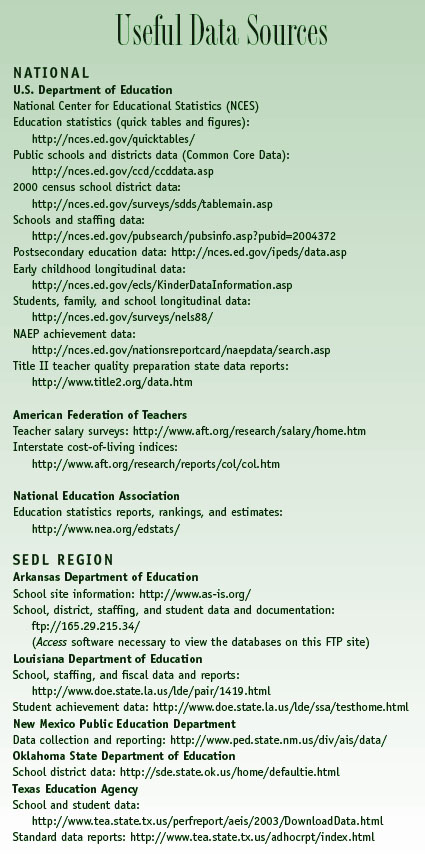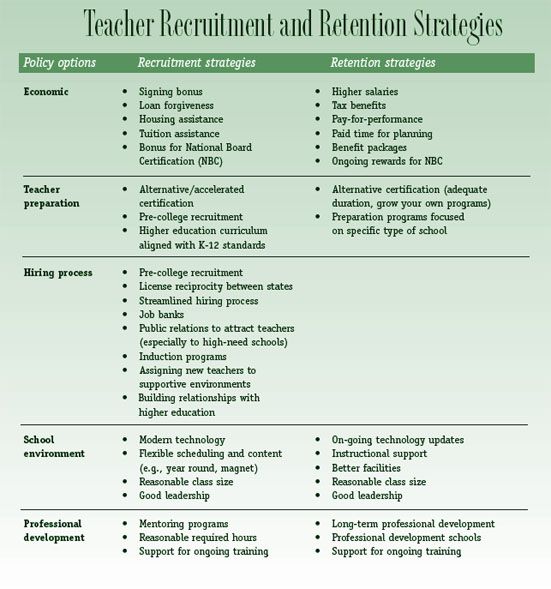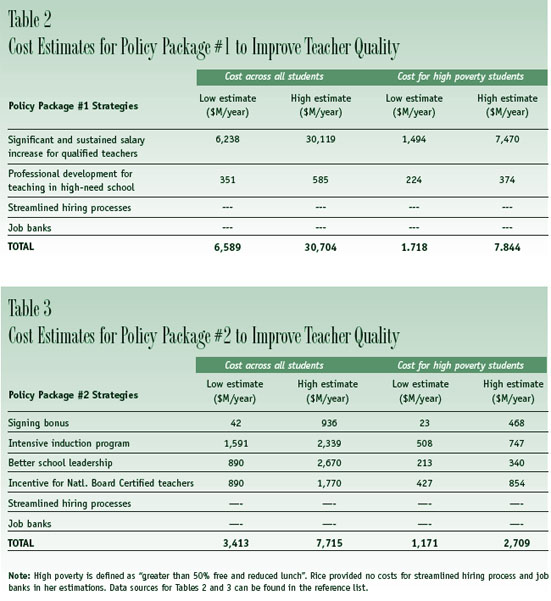Best-Fit Policy Decision Making
Rice's best-fit approach to improving teacher resources is a multi-step decision framework to guide policymakers as they consider alternative investments in policies related to teachers. This approach helps policymakers identify a set or "package" of policies to address their state's specific teacher resource needs. There is no single strategy to deal with teacher quality under all circumstances. Instead policymakers must search out the strategies that will work best within their specific state and local contexts. Policymakers can take three basic steps to apply the best-fit model to their individual contexts:
- Identify the teacher resource problem using adequate data
- Explore available policy alternatives to address the multiple dimensions of the problem
- Evaluate the cost-effectiveness of alternative sets of policies
Teacher quality is multidimensional
A key point to remember is that teacher quality is multi-dimensional and teacher resource policies must reflect this. So it is critical to first be aware of what the research says about teacher resources. Then know what data are available at state and local levels to both identify the teacher resource problem and help answer questions related to the various dimensions of teacher quality. Those dimensions include:
- Quality of teacher preparation
- Quantity of training opportunities
- Adequate pool of qualified teachers
- Recruitment of teachers
- Retention of teachers
- Distribution and assignment of teachers
- Quality and availability of professional development opportunities
- Geographic contexts and population demographics
Identify the problem

Specifying the teacher resource problem can be challenging, but is a necessary first step to developing effective teacher policy. The problem may not be obvious or seen as a concern by everyone. Typically, a problem occurs when there is a difference between "what is" and "what should be." Knowing what your current teacher resources are (e.g., the different characteristics of teachers or avenues to certification) is important in figuring out how to reach your goals to get to where you should be. These goals may be based on legislation, teacher and administrator decisions, or community input.
Understanding the scope of "what is" and "what should be", especially in relation to the various dimensions of teacher quality mentioned earlier, is an important step in identifying the problem. To begin this process, ask some preliminary questions such as:
- What will it take to comply with teacher quality laws, regulations, or requirements?
- Is the teacher resource problem in particular areas, for particular students, or at particular times?
- Is the problem immediate or long term, one-time or on-going?
- What do current teacher policies assume about teacher quality and is this supported by data?
- Do we have teacher resource data available to us now? If not, how would we get it?
- Who (e.g., teachers, students, administrators, parents, the community) does this problem affect? And, how does it affect them?
So where do we find the answers to these questions? Answers may come from existing research literature; from organizations conducting research or clearinghouses for information; from communications with teachers, administrators, and other practitioners; and from data sources readily available on the Internet (see "Useful Data Sources" below). Many answers may be found in the community so talk to local teacher organizations or chapters or education service centers. Most importantly, see what the data your state collects can tell you. Another good idea is to examine how other states have looked at the problem and what they have done.
Explore policy alternatives
Once the problem is identified, the search for policy alternatives can begin. Typically, the range of policies implemented to improve teacher resources include:
- Economic incentives
- Teacher preparation program reforms
- Hiring processes
- School environment changes
- Professional development initiatives
The particular teacher resource challenge you face will dictate what policy best fits the problem. Review current and previous state and local policies. Find out when the policies were implemented, how they were implemented, if there was total buy-in from those involved and those potentially impacted, and what investment was made into these policies. Scan the policy strategies being used in practice, i.e., specific actions taken to carry out the various types of policies as listed above. Then develop a package of strategies that align with the dimensions of your identified problem.
 Keep in mind that policies can be more effective in combination than as individual stand-alone policies. For example, mentor teacher programs may be much more effective when combined with more functional training, incentive pay for advanced training, and strong induction programs. By themselves, these policy options may not be sufficient, but rather should be part of a package of strategies designed to meet multiple demands at the local and state levels. Also, pay attention to the ways various policies interact; are they complementary or do they compete with one another? One state policy might reduce class size, increasing the demand for additional teachers, while another requires all teachers have subject-specific certification, limiting the pool of potential teachers. With careful consideration of the options available,decisions can be made to develop an appropriate policy package.
Keep in mind that policies can be more effective in combination than as individual stand-alone policies. For example, mentor teacher programs may be much more effective when combined with more functional training, incentive pay for advanced training, and strong induction programs. By themselves, these policy options may not be sufficient, but rather should be part of a package of strategies designed to meet multiple demands at the local and state levels. Also, pay attention to the ways various policies interact; are they complementary or do they compete with one another? One state policy might reduce class size, increasing the demand for additional teachers, while another requires all teachers have subject-specific certification, limiting the pool of potential teachers. With careful consideration of the options available,decisions can be made to develop an appropriate policy package.
Let's look at how this step of Rice's model can be applied to one prevalent teacher resource issue across SEDL's region, that of recruiting and retaining quality teachers. First, a review of current and previous teacher quality policies might indicate many new and revised recruitment and retention policies, particularly since 2000 in response to the NCLB teacher quality requirements. The policies may have been prompted by state commission recommendations, teacher and administrator association advocacy, or student achievement improvement goals. The policies might include a variety of means to respond to this problem (see "Teacher Recruitment and Retention Strategies" below). These strategies include monetary, staff, time, physical, and parent/community resources.
One set of policy alternatives, we will designate as Policy Package #1, that might respond to the need for improving recruitment and retention of quality teachers could include a significant and sustained salary increase for qualified teachers willing to work in high-need schools, a professional development module for teaching in this type of school, streamlined hiring application and interview processes, and job banks available through a variety of sources (e.g., nationally affiliated internet-based lists, recruitment fairs, state-run databases). Another, labeled Policy Package #2, might include a signing bonus, an intensive induction program, increased school administrator salary and training, an incentive for teachers holding national Board Certification, and streamlined hiring application and interview processes. Which of these policy packages is preferable to meet the identified need to recruit and retain quality teachers? Taking a look at each policy package's cost-effectiveness will help answer this question,which is the last step in Rice's model.
Evaluate policy cost-effectiveness
How can cost-effective policies addressing teacher resource problems be best established? Ask these guiding questions:
- Do I have information about the costs and effectiveness of policy options?
- Are all costs considered (e.g., hidden costs, short- versus long-term costs)?
- How do these policies affect the expenditures in other budget areas?
- Could policies be put together in ways that make them more effective and/or less costly?
- How could the state finance the new policy package?
Know the cost and effectiveness of policy options. In estimating the cost of policies, consider their full cost,i.e., direct and indirect costs. For example, a reduction in class size can trigger expenses not only for additional teachers, but for additional classroom facilities or equipment, new or different recruitment efforts, and professional development opportunities to help teachers be more effective in smaller classes. Obviously, the most desirable policy package has the lowest cost and greatest effectiveness. Unfortunately, the effectiveness of many policy strategies is not evaluated and hidden costs are not always well documented. Establish more comprehensive and useful data collection systems and ensure cost-effectiveness evaluations of policy alternatives are conducted regularly.

In times of budget constraints, everyone is concerned about investing wisely. One way to do so is to reallocate resources, i.e., use funds previously allocated in the budget for policies not currently aimed at the teacher resource problem. Other options include targeting interventions to save resources. For example, rather than implementing a small teacher salary increase across the state, targeting a more substantial salary increase to specific types of teachers (e.g., high school math or science teachers, teachers in schools identified as needing improvement, or English as a Second Language teachers) might have a greater effect, at possibly a lower cost.

Using a variety of data sources, Rice estimated the national cost of Policy Packages #1 and #2 (described earlier in "Explore Policy Alternatives") for all students and for a targeted population of high poverty students (see Tables 2 and 3). This type of cost analysis is an important first step in determining what set of policies is most cost-effective for responding to the problem. See if state or local fiscal data is available first to get actual costs. If actual costs are not available, estimations like these can be used to provide a sense of the range of costs associated with various policy alternatives.
The estimations of these two policy packages clearly show that costs can be quite different. Raising salaries and providing increased financial incentives to teachers, especially across the board, are typically at a higher cost than other policy alternatives. That does not automatically mean that these are not good strategies to use. What should be determined is whether these kinds of strategies will produce the desired results more efficiently than other less costly strategies. Ultimately, does the policy package produce the important results we are all looking for — student success? The best-fit model is a tool to help provide answers to this question.
In addition, attention should be paid to packaging various policies in productive ways that address the various dimensions of the problem. For example, if the major problem is the recruitment of teachers to low-performing schools, then a policy that involves signing bonuses targeted to qualified teachers willing to teach in those schools may be preferable to policies that offer long-term salary increases to all teachers, particularly if the signing bonuses are coupled with intensive induction programs to help teachers be successful in low-performing schools.
Clearly, more data-based information is needed to determine the cost effectiveness of policy options. Our policy research at SEDL focuses on the link between how education resources are allocated and student performance. Currently, we are examining the capacity of state data in Arkansas, Louisiana, New Mexico, and Texas to answer policy questions about instructional resources and student achievement (see "SEDL Policy Research on Instructional Resources"). Our future policy research will more specifically focus on how teacher salaries, and the teacher qualifications those salaries buy, impact student performance in high need schools (i.e., rural, urban,high poverty, and high minority).
Next Page: Putting the Best-Fit Model to Use

